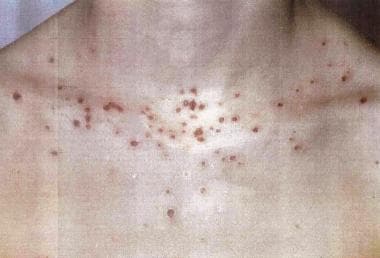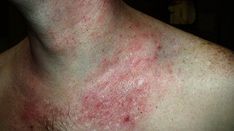Quintanilla-Martinez L, Fend F. Deciphering hydroa vacciniforme. Blood. 2019 Jun 27. 133 (26):2735-2737. [QxMD MEDLINE Link].
Pahlow Mose A, Fisker N, Clemmensen O, Bygum A. Antiviral treatment of a boy with EBV-associated hydroa vacciniforme. BMJ Case Rep. 2014 Nov 24. 2014:[QxMD MEDLINE Link].
Almeida HL Jr, Kopp J, Jorge VM, Sartori DS, Velloso CD. Extensive hydroa vacciniforme. An Bras Dermatol. 2013 Aug. 88(4):620-2. [QxMD MEDLINE Link]. [Full Text].
Greywal T, Ly M, Wang A, Friedlander SF. Hydroa vacciniforme and granulomatous uveitis in association with EBV. J Am Acad Dermatol. May 2016. 74:AB226.
Iwatsuki K, Satoh M, Yamamoto T, Oono T, Morizane S, Ohtsuka M, et al. Pathogenic link between hydroa vacciniforme and Epstein-Barr virus-associated hematologic disorders. Arch Dermatol. 2006 May. 142(5):587-95. [QxMD MEDLINE Link].
Verneuil L, Gouarin S, Comoz F, Agbalika F, Creveuil C, Varna M, et al. Epstein-Barr virus involvement in the pathogenesis of hydroa vacciniforme: an assessment of seven adult patients with long-term follow-up. Br J Dermatol. 2010 Jul. 163 (1):174-82. [QxMD MEDLINE Link].
Halasz CL, Leach EE, Walther RR, Poh-Fitzpatrick MB. Hydroa vacciniforme: induction of lesions with ultraviolet A. J Am Acad Dermatol. 1983 Feb. 8(2):171-6. [QxMD MEDLINE Link].
Chen CC, Chang KC, Medeiros LJ, Lee JY. Hydroa Vacciniforme and Hydroa Vacciniforme-Like Lymphoproliferative Disorder: A Spectrum of Disease Phenotypes Associated with Ultraviolet Irradiation and Chronic Epstein-Barr Virus Infection. Int J Mol Sci. 2020 Dec 7. 21 (23):[QxMD MEDLINE Link].
Annamalai R. Hydroa vacciniforme in three alternate siblings. Arch Dermatol. 1971 Feb. 103(2):224-5. [QxMD MEDLINE Link].
Gupta G, Man I, Kemmett D. Hydroa vacciniforme: A clinical and follow-up study of 17 cases. J Am Acad Dermatol. 2000 Feb. 42 (2 Pt 1):208-13. [QxMD MEDLINE Link].
Nomura H, Suzuki H, Egami S, Yokoyama T, Sugiura M, Tomita K, et al. A patient with elderly-onset atypical hydroa vacciniforme with an indolent clinical course. Br J Dermatol. 2015 Sep. 173 (3):801-5. [QxMD MEDLINE Link].
Cohen JI, Manoli I, Dowdell K, Krogmann TA, Tamura D, Radecki P, et al. Hydroa vacciniforme-like lymphoproliferative disorder: an EBV disease with a low risk of systemic illness in whites. Blood. 2019 Jun 27. 133 (26):2753-2764. [QxMD MEDLINE Link].
Yesudian PD, Sharpe GR. Hydroa vacciniforme with oral mucosal involvement. Pediatr Dermatol. 2004 Sep-Oct. 21(5):555-7. [QxMD MEDLINE Link].
Jeng BH, Margolis TP, Chandra NS, McCalmont TH. Ocular findings as a presenting sign of hydroa vacciniforme. Br J Ophthalmol. 2004 Nov. 88(11):1478-9. [QxMD MEDLINE Link].
Wisuthsarewong W, Leenutaphong V, Viravan S. Hydroa vacciniforme with ocular involvement. J Med Assoc Thai. 1998 Oct. 81(10):807-11. [QxMD MEDLINE Link].
Kim WS, Yeo UC, Chun HS, Lee ES. A case of hydroa vacciniforme with unusual ear mutilation. Clin Exp Dermatol. 1998 Mar. 23(2):70-2. [QxMD MEDLINE Link].
Haddad JM, Monroe HR, Hardin J, Diwan AH, Hsu S. Hydroa vacciniforme: a rare photodermatosis. Dermatol Online J. 2014 Aug 17. 20 (8):[QxMD MEDLINE Link].
Iwatsuki K, Ohtsuka M, Akiba H, Kaneko F. Atypical hydroa vacciniforme in childhood: from a smoldering stage to Epstein-Barr virus-associated lymphoid malignancy. J Am Acad Dermatol. 1999 Feb. 40(2 Pt 1):283-4. [QxMD MEDLINE Link].
Iwatsuki K, Ohtsuka M, Harada H, Han G, Kaneko F. Clinicopathologic manifestations of Epstein-Barr virus-associated cutaneous lymphoproliferative disorders. Arch Dermatol. 1997 Sep. 133(9):1081-6. [QxMD MEDLINE Link].
Hirai Y, Yamamoto T, Kimura H, Ito Y, Tsuji K, Miyake T, et al. Hydroa vacciniforme is associated with increased numbers of Epstein-Barr virus-infected γδdT cells. J Invest Dermatol. 2012 May. 132(5):1401-8. [QxMD MEDLINE Link].
Magaña M, Sangüeza P, Gil-Beristain J, Sánchez-Sosa S, Salgado A, Ramón G, et al. Angiocentric cutaneous T-cell lymphoma of childhood (hydroa-like lymphoma): a distinctive type of cutaneous T-cell lymphoma. J Am Acad Dermatol. 1998 Apr. 38(4):574-9. [QxMD MEDLINE Link].
Tokura Y, Ishihara S, Ohshima K, Hidano A, Koide M, Seo N, et al. Severe mosquito bite hypersensitivity, natural killer cell leukaemia, latent or chronic active Epstein-Barr virus infection and hydroa vacciniforme-like eruption. Br J Dermatol. 1998 May. 138(5):905-6. [QxMD MEDLINE Link].
Yamamoto T, Tsuji K, Suzuki D, Morizane S, Iwatsuki K. A novel, noninvasive diagnostic probe for hydroa vacciniforme and related disorders: detection of latency-associated Epstein-Barr virus transcripts in the crusts. J Microbiol Methods. 2007 Feb. 68(2):403-7. [QxMD MEDLINE Link].
Takeuchi T, Kamide R. Severe hydroa vacciniforme-like eruptions confined to sun-exposed areas. J Dermatol. 2011 Apr. 38(4):386-9. [QxMD MEDLINE Link].
Wang M, Wang S, Yang QP, Liu YM, Gao LM, Sun H, et al. Hydroa vacciniforme-like lymphoma of an adult: a case report with review of the literature. Diagn Pathol. 2013 May 1. 8:72. [QxMD MEDLINE Link]. [Full Text].
Sangueza M, Plaza JA. Hydroa vacciniforme-like cutaneous T-cell lymphoma: clinicopathologic and immunohistochemical study of 12 cases. J Am Acad Dermatol. 2013 Jul. 69(1):112-9. [QxMD MEDLINE Link].
Uchiyama M, Tsuboi R, Kusunoki T. A case of recurrent facial herpes simplex mimicking hydroa vacciniforme. Int J Dermatol. 2015 Mar. 54 (3):e84-5. [QxMD MEDLINE Link].
Magaña M, Massone C, Magaña P, Cerroni L. Clinicopathologic Features of Hydroa Vacciniforme-Like Lymphoma: A Series of 9 Patients. Am J Dermatopathol. 2015 Sep 10. [QxMD MEDLINE Link].
Miyake T, Iwatsuki K, Hirai Y, Yamamoto T, Hamada T, Fujii K, et al. The aim of the measurement of Epstein-Barr virus DNA in hydroa vacciniforme and hypersensitivity to mosquito bites. J Med Virol. 2020 Apr 7. [QxMD MEDLINE Link].
Mehta RV, Shenoi SD, Balachandran C, Pai S. Minimal erythema response (MED) to solar simulated irradiation in normal Indian skin. Indian J Dermatol Venereol Leprol. 2004 Sep-Oct. 70 (5):277-9. [QxMD MEDLINE Link].
Levoska MA, Cohen JI, Manoli I, Richard Lee CC, Ching SST, Shand J, et al. Recurrent scarring papulovesicular lesions on sun-exposed skin in a 22-year-old man. J Am Acad Dermatol. 2018 Mar. 78 (3):637-642. [QxMD MEDLINE Link].
Collins P, Ferguson J. Narrow-band UVB (TL-01) phototherapy: an effective preventative treatment for the photodermatoses. Br J Dermatol. 1995 Jun. 132(6):956-63. [QxMD MEDLINE Link].
Hashizume H, Tokura Y, Oku T, Iwamoto Y, Takigawa M. Photodynamic DNA-breaking activity of serum from patients with various photosensitivity dermatoses. Arch Dermatol Res. 1995. 287(6):586-90. [QxMD MEDLINE Link].
Ziering CL, Rabinowitz LG, Esterly NB. Antimalarials for children: indications, toxicities, and guidelines. J Am Acad Dermatol. 1993 May. 28(5 Pt 1):764-70. [QxMD MEDLINE Link].
Bruderer P, Shahabpour M, Christoffersen S, André J, Ledoux M. Hydroa vacciniforme treated by a combination of beta-carotene and canthaxanthin. Dermatology. 1995. 190(4):343-5. [QxMD MEDLINE Link].
Omenn GS, Goodman GE, Thornquist MD, Balmes J, Cullen MR, Glass A, et al. Effects of a combination of beta carotene and vitamin A on lung cancer and cardiovascular disease. N Engl J Med. 1996 May 2. 334(18):1150-5. [QxMD MEDLINE Link].
The Alpha-Tocopherol, Beta Carotene Cancer Prevention Study Group. The effect of vitamin E and beta carotene on the incidence of lung cancer and other cancers in male smokers. N Engl J Med. 1994 Apr 14. 330(15):1029-35. [QxMD MEDLINE Link].
Blackwell V, McGregor JM, Hawk JL. Hydroa vacciniforme presenting in an adult successfully treated with cyclosporin A. Clin Exp Dermatol. 1998 Mar. 23(2):73-6. [QxMD MEDLINE Link].
Rhodes LE, White SI. Dietary fish oil as a photoprotective agent in hydroa vacciniforme. Br J Dermatol. 1998 Jan. 138(1):173-8. [QxMD MEDLINE Link].
Rhodes LE, Durham BH, Fraser WD, Friedmann PS. Dietary fish oil reduces basal and ultraviolet B-generated PGE2 levels in skin and increases the threshold to provocation of polymorphic light eruption. J Invest Dermatol. 1995 Oct. 105(4):532-5. [QxMD MEDLINE Link].
Durbec F, Reguiaï Z, Léonard F, Pluot M, Bernard P. Efficacy of ?-3 Polyunsaturated Fatty Acids for the Treatment of Refractory Hydroa Vacciniforme. Pediatr Dermatol. 2011 Oct 4. [QxMD MEDLINE Link].











